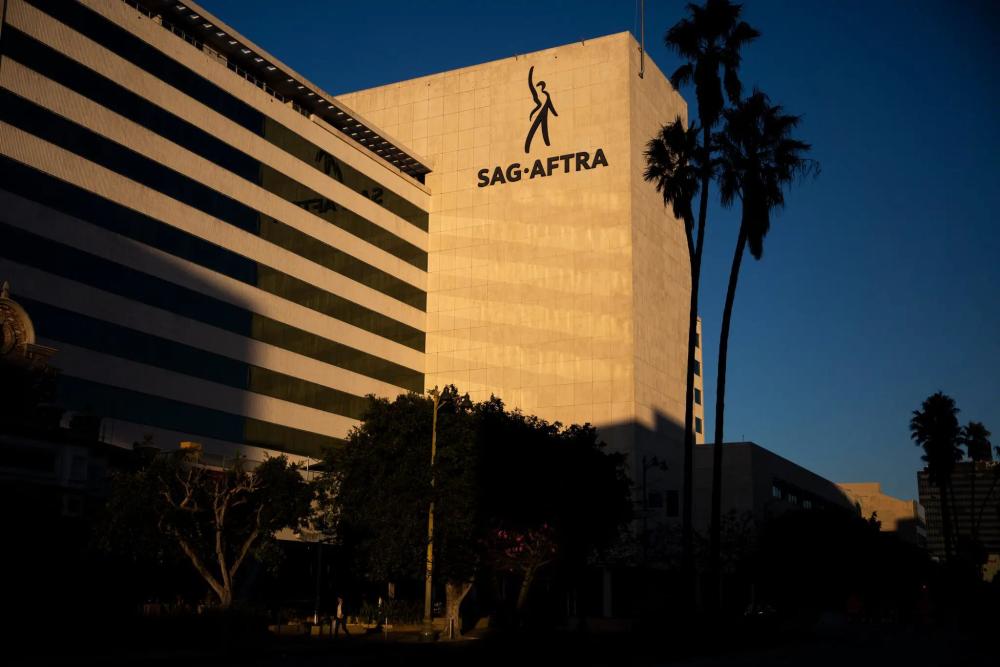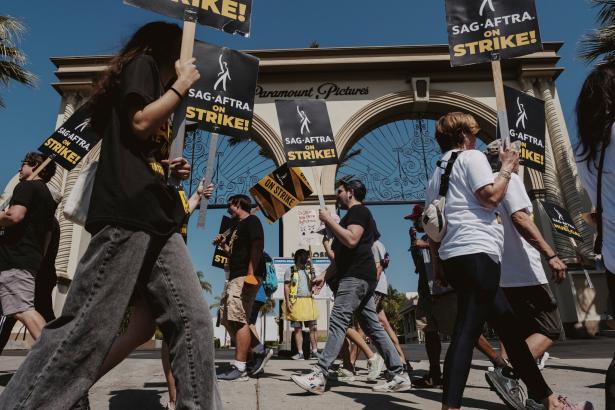One of the longest labor crises in Hollywood history is finally coming to an end.
SAG-AFTRA, the union representing tens of thousands of actors, reached a tentative deal for a new contract with entertainment companies on Wednesday, clearing the way for the $134 billion American movie and television business to swing back into motion.
Hollywood’s assembly lines have been at a near-standstill since May because of a pair of strikes by writers and actors, resulting in financial pain for studios and for many of the two million Americans — makeup artists, set builders, location scouts, chauffeurs, casting directors — who work in jobs directly or indirectly related to making TV shows and films.
Upset about streaming-service pay and fearful of fast-developing artificial intelligence technology, actors joined screenwriters on picket lines in July. The writers had walked out in May over similar concerns. It was the first time since 1960, when Ronald Reagan was the head of the actors’ union and Marilyn Monroe was still starring in films, that actors and writers were both on strike.
The Writers Guild of America, which represents 11,500 screenwriters, reached a tentative agreement with studios on Sept. 24 and ended its 148-day strike on Sept. 27. In the coming days, SAG-AFTRA members will vote on whether to accept their union’s deal, which includes hefty gains, like increases in compensation for streaming shows and films, better health care funding, concessions from studios on self-taped auditions, and guarantees that studios will not use artificial intelligence to create digital replicas of their likenesses without payment or approval.
SAG-AFTRA, however, failed to receive a percentage of streaming service revenue. It had proposed a 2 percent share — later dropped to 1 percent, before a pivot to a per-subscriber fee. Fran Drescher, the union’s president, had made the demand a priority, but companies like Netflix balked, calling it “a bridge too far.”
Instead, the Alliance of Motion Picture and Television Producers, which bargains on behalf of entertainment companies, proposed a new residual for streaming programs based on performance metrics, which the union, after making some adjustments, agreed to take.
At 118 days, it was the longest movie and television strike in the union’s 90-year history. SAG-AFTRA said in a terse statement that its negotiating committee had voted unanimously to approve the tentative deal, which will proceed to the union’s national board on Friday for “review and consideration.”
It added, “Further details will be released following that meeting.”
Shaan Sharma, a member of the union’s negotiating committee, said he had mixed emotions about the tentative deal, though he declined to go into specifics because the SAG-AFTRA board still needed to review it.
“They say a negotiation is when both sides are unhappy because you can’t get everything you want on either side,” he said, adding, “You can be happy for the deal overall, but you can feel a sense of loss for something that you didn’t get that you thought was important.”
Ms. Drescher called the agreement “historic” in a post on Instagram. “We did it!!!!” she wrote. She and other SAG-AFTRA officials had come under severe pressure from agents, crew member unions and even some of her own members, including George Clooney and Ben Affleck, to wrap up what had started to feel like an interminable negotiation.
“I’m relieved,” Kevin Zegers, an actor most recently seen in the ABC show “The Rookie: Feds,” said in an interview after the union’s announcement. “If it didn’t end today, there would have been riots.”
The studio alliance said in a statement that the tentative agreement “represents a new paradigm,” giving SAG-AFTRA “the biggest contract-on-contract gains in the history of the union.”
There is uncertainty over what a poststrike Hollywood will look like. But one thing is certain: There will be fewer jobs for actors and writers in the coming years, undercutting the wins that unions achieved at the bargaining table.
Even before the strikes, entertainment companies were cutting back on the number of television shows they ordered, a result of severe pressure from Wall Street to turn money-losing streaming services into profitable businesses. Analysts expect companies to make up for the pair of pricey new labor contracts by reducing costs elsewhere, including by making fewer shows and canceling first-look deals.

The actors, like the writers, said the streaming era had negatively affected their working conditions and compensation. Jenna Schoenefeld for The New York Times
For the moment, however, the agreements with actors and writers represent a capitulation by Hollywood’s biggest companies, which started the bargaining process with an expectation that the unions, especially SAG-AFTRA, would be relatively compliant. Early in the talks, for instance, the studio alliance — Netflix, Disney, NBCUniversal, Apple, Amazon, Sony, Paramount, Warner Bros. — refused to negotiate on multiple union proposals. “Rejected our proposal, refused to make a counter” became a rallying cry among the striking workers.
As the studio alliance tried to limit any gains, the companies cited business challenges, including the rapid decline of cable television and continued streaming losses. Disney, struggling with $4 billion in streaming losses in 2022, eliminated 7,000 jobs in the spring.
But the alliance underestimated the pent-up anger pulsating among the studios’ own workers. Writers and actors called the moment “existential,” arguing that the streaming era had deteriorated the working conditions and compensation for rank-and-file members of their professions so much that they could no longer make a living. The companies brushed such comments aside as union bluster and Hollywood dramatics. They found out the workers were serious.
With the strikes dragging into the fall and the financial pain on both sides mounting, the studio alliance reluctantly switched from trying to limit gains to figuring out how to get Hollywood’s creative assembly lines running again — even if that meant bending to the will of the unions.
“It was all macho, tough-guy stuff from the companies for a while,” said Jason E. Squire, professor emeritus at the University of Southern California’s School of Cinematic Arts. “But that certainly did change.”
There had previously been 15 years of labor peace in Hollywood.
“The executives of these companies didn’t need to worry about labor very much — they worried about other things,” Chris Keyser, a chair of the Writers Guild negotiating committee, said in an interview after the writers’ strike concluded. “They worried about Wall Street and their free cash flow, and all of that.”
Mr. Keyser continued: “They could say to their labor executives, ‘Do the same thing you’ve been doing year after year. Just take care of that, because labor costs are not going to be a problem.’ Suddenly, that wasn’t true anymore.” As a result of the strikes, studios are widely expected to overhaul their approach to union negotiations, which in many ways dates to the 1980s.
Writers Guild leaders called their deal “exceptional” and “transformative,” noting the creation of viewership-based streaming bonuses and a sharp increase in royalty payments for overseas viewing on streaming services. Film writers received guaranteed payment for a second draft of screenplays, something the union had tried but failed to secure for at least two decades.
The Writers Guild said the contract included enhancements worth roughly $233 million annually. When bargaining started in the spring, the guild proposed $429 million in enhancements, while studios countered with $86 million, according to the guild.
For an industry upended by the streaming revolution, which the pandemic sped up, the tentative accord takes a meaningful step toward stabilization. About $10 billion in TV and film production has been on hold, according to ProdPro, a production tracking service. That amounts to 176 shows and films.
The fallout has been significant, both inside and outside the industry. California’s economy alone has lost more than $5 billion, according to Gov. Gavin Newsom. Because the actors’ union prohibited its members from participating in promotional campaigns for already-finished work, studios pulled movies like “Dune: Part Two” from the fall release schedule, forgoing as much as $1.6 billion in worldwide ticket sales, according to David A. Gross, a film consultant.
With labor harmony restored, the coming weeks should be chaotic. Studio executives and producers will begin a mad scramble to secure soundstages, stars, insurance, writers and crew members so productions can start running again as quickly as possible. Because of the end-of-year holidays, some projects may not restart until January.
Both sides will have to go through the arduous process of working together again after a searing six-month standoff. The strikes tore at the fabric of the clubby entertainment world, with actors’ union leaders describing executives as “land barons of a medieval time,” and writers and actors still fuming that it took studio executives months, not weeks, to reach a deal.
Workers and businesses caught in the crossfire were idled, potentially leaving bitter feelings toward both sides.
And it appears that Hollywood executives will now have to contend with a resurgent labor force, mirroring many other American businesses. In recent weeks, production workers at Walt Disney Animation voted to unionize, as did visual-effects workers at Marvel.
Contracts with powerful unions that represent Hollywood crews will expire in June and July, and negotiations are expected to be fractious.
“It seemed apparent early on that we were part of a trend in American society where labor was beginning to flex its muscles — where unions were beginning to reassert their power,” said Mr. Keyser, the Writers Guild official.
Brooks Barnes and Nicole Sperling reported from Los Angeles, and John Koblin from New York.
Brooks Barnes covers all things Hollywood. He joined The New York Times in 2007 and previously worked at The Wall Street Journal. More about Brooks Barnes
John Koblin covers the television industry. He is the co-author of “It’s Not TV: The Spectacular Rise, Revolution, and Future of HBO.” More about John Koblin
Nicole Sperling is a media and entertainment reporter, covering Hollywood and the burgeoning streaming business. She joined The Times in 2019. She previously worked for Vanity Fair, Entertainment Weekly and The Los Angeles Times. More about Nicole Sperling


Spread the word